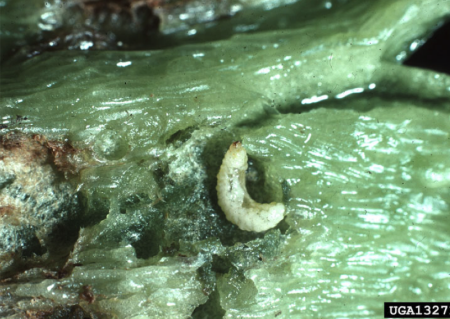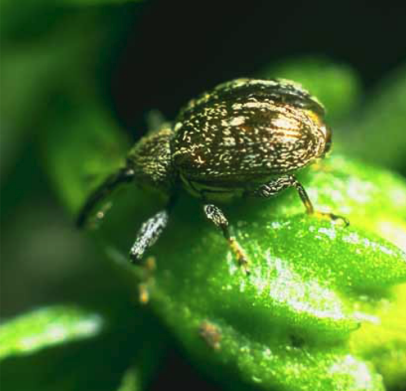Anthonomus eugenii (Cano)
Author: David Riley, Professor, University of Georgia, 2018
Description
Immature stages: Eggs are oval and white when first deposited in the flower or fruit wall. They can only be found if the plant is dissected. Larvae are the grub type and are white to grayish with a yellowish brown head. They lack legs and have few large hairs. During their first instar, or developmental stage, larvae are about 1 mm long, and last instar larvae reach a maximum of about 5 mm. Pupae whitish, have structure of the adults except the wings are not fully developed, and have large setae (hairs) on the thorax and abdomen.
Adult stages: Pepper weevil adults are small varying in length from 2.0 – 3.5 mm. The body is arched with a long stout beak, typical of weevils. The femora of the front legs has a sharp spur near the end. Adults are dark, ranging in color from dark mahogany to nearly black. The thorax and elytra are covered with light scales.


Biology
Life Cycle: Adults can live for months in the pepper crop and overwinter in an active state, but only if food is available. This limits its survival in regions with harsh winters. Eggs are deposited into flower buds or small fruit, but larger fruit are utilized when smaller fruit are limited. The female chews an egg cavity into the bud or fruit, places a single egg into the cavity, and seals the puncture with a light brown fluid that hardens and darkens, resulting in the characteristic ‘stipple’ on fruit. Generally, a single individual develops within a flower bud or small fruit, but several weevils may develop within larger fruit. Females lay 5-7 eggs per day, eggs hatch in 3 – 5 days. Larvae feed inside the bud/fruit and develop through 3 instars in about 12 days. The pupal stage within the fruit requires about 5 days. Adults emerge within the bud/fruit and chews a circular exit hole.
Damage
Pepper weevil is the most severe pest of pepper and eggplant. Prior to the presence of fruit, adults will feed on leaves. On flower buds, adult and larval feeding causes bud drop. Fruit drop is also common when small fruit are attacked. Heavy infestations are capable of causing near 100 percent loss of fruit. When larger fruit are attacked, the core will usually turn brown around the cavity where they pupate. The stem of infested fruit generally turns yellow. Weevils can also develop within large marketable fruit, causing fruit contamination, rejection of produce shipments.
Management
Because pepper weevil do not become dormant and have a limited host range, thorough sanitation can greatly reduce populations. If established, scheduled insecticide applications beginning at first flowering are necessary. Prevent carryover of infested pods between seasons.
